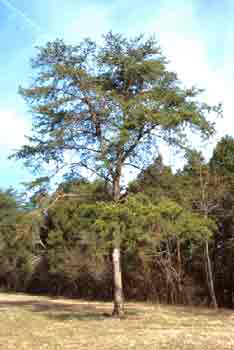 Virginia Pine - Pinus virginiana
Virginia Pine - Pinus virginiana
Pine Family (Pinaceae)
- Native habitat: New York to Alabama.
- Growth habit: Broad, open pyramid when young with an irregular silhouette; becomes scrubby with long limbs with age.
- Tree size: 15 to 40 feet tall with a spread of 10 to 30 feet. Growth rate is slow.
- Flower and fruit: Monoecious. Male flowers are orange-brown; female flowers are pale green. Cones are borne in groups of two to four or singly, and are 1½ to 3 inches long. Cones, which are dark brown at maturity, reach maturity during their second autumn. They have an appendage that makes them sharp. Cones persist on the tree for eight or more years, giving it an unkempt appearance or character, depending on your perspective.
 Leaf: Needles, in bundles of two, are 1½ to 3 inches long and yellow-green to dark green. Needles remain on the tree for three to four years and are twisted.
Leaf: Needles, in bundles of two, are 1½ to 3 inches long and yellow-green to dark green. Needles remain on the tree for three to four years and are twisted.- Hardiness: Winter hardy to USDA zone 4.
The cones of Virginia pine have a prickly appendage that makes them sharp. Low branches on Virginia pine tend to persist, making it a popular Christmas tree in the South. Pruning or shearing is used to improve the shape of the tree for use as a Christmas tree.
 Virginia pine is known for taking over abandoned land and holding it for approximately 75 years before other species take over. Virginia pine has weak wood and is susceptible to breakage.
Virginia pine is known for taking over abandoned land and holding it for approximately 75 years before other species take over. Virginia pine has weak wood and is susceptible to breakage.
National champion Virginia pines are in Madisonville, Ky. (103 feet tall and 50 feet wide) and Jefferson County, Ala. (114 feet tall and 43 feet wide). This tree was introduced into the landscape before 1739.


